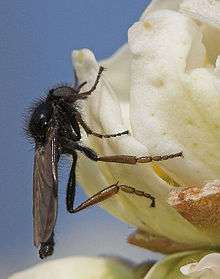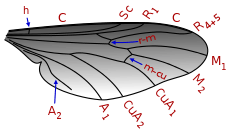Bibionidae
| Bibionidae | |
|---|---|
 | |
| Bibio johannis | |
| Scientific classification | |
| Kingdom: | Animalia |
| Phylum: | Arthropoda |
| Class: | Insecta |
| Order: | Diptera |
| Suborder: | Nematocera |
| Infraorder: | Bibionomorpha |
| Superfamily: | Bibionoidea |
| Family: | Bibionidae |
| Genera | |
| |
| Wikispecies has information related to: Bibionidae |
The Bibionidae (March flies and lovebugs) are a family of flies (Diptera). About 650-700 species are known worldwide.
Description
Bibionidae are medium-sized flies with a body length from 4.0 to 10.0 mm. The body is black, brown, or rusty, and thickset, with thick legs. The antennae are moniliform. The front tibiae bear large strong spurs or a circlet of spines. The tarsi are five-segmented and bear tarsal claws, pulvilli, and a well developed empodium. The wings have two basal cells (posterior basal wing cell and basal wing cell), but are without a discoidal wing cell. R4+5 is simple or branched; at most, only three branches of R developed. The leading edge wing veins are stronger than the weak veins of the trailing edge.

Biology
Bibionid larvae grow up in grassy areas and are herbivores and scavengers feeding on dead vegetation or living plant roots. Some species are found in compost.[1] Larvae are sometimes found in pockets in which sometimes up to 200 specimens have been counted. Adults of most Plecia and some species of Bibio do not eat, but subsist solely on the food taken in during the larval stage and drop steadily when in flight until they are a few inches above the ground, hovering slowly. Adult-stage bibionids are quite short-lived, and some species of Plecia (lovebugs) spend much of their adult lives copulating. The male and female (lovebugs) attach themselves at the rear of the abdomen and remain that way at all times, even in flight. Adults swarm after synchronous emergence, sometimes in enormous numbers.[2]
Fossil record
Bibionids have the most extensive fossil record of any dipteran family. Fossil bibionids are known questionably from the Jurassic, while some forms from the early part of the Upper Cretaceous look quite similar to modern species. Bibionid flies are very abundant among insect fossils from the Tertiary period, and a large number of species have been described, although often based on highly fragmentary material. Most fossil species are easily identified with extant genera. In particular, the genera Plecia and Bibio are abundant among Tertiary fossils. Fossils from Europe include a large number of specimens of the mainly tropical genus Plecia which is today entirely absent from Europe, demonstrating a warmer climate during the Tertiary.
Economic importance
Adults feed on the nectar of flowers of fruit trees and especially on flowers of umbelliferous plants; often swarming in mass flights in spring. Adults are important pollinators. Larvae play an important role in formation and accumulation of humus in soil. Some larvae are serious plant pests, especially of pasture land and other agronomic crops including cereal crops, vegetables, forage crops, and seedlings of many other plants.[3][4][2][5][6][7][8]
References
- ↑ Hardy, 1981
- 1 2 Freeman, Paul; Lane, Richard P. (1985). "Bibionid and Scatopsid flies, Diptera: Bibionidae & Scatopsidae" (Print). Handbooks for the identification of British insects. 9 (7). London: Royal Entomological Society of London: 74.
- ↑ Hardy D.E.(1981) Bibionidae. in: McAlpine J.F. (Ed.), Manual of Nearctic Diptera. Agriculture Canada, Ottawa, pp. 217-222.
- ↑ Darvas, B., Skuhravá, M., Andersen, A., 2000, Agricultural dipteran pests of the Palaearctic Region. In: Papp, L., Darvas, B. (Eds.). Contributions to a Manual of Palaearctic Diptera with Special Reference to Flies of Economic Importance. Science Herald, Bupapest, 565-649.
- ↑ Bollow, H. 1954. Die Landwirtschaftlich wichtigen Haarmticken. Z. PflBau PflSchutz 5 (49): 197-232.
- ↑ Maier-Bode, [-]. 1936. Die Gartenhaarmticke (Bibio hortulanus) als Roggen-schiidling. NachrBl. dt. PflSchutzdienst., Berl. l6: 10.
- ↑ Spitzer, K. 1966. An example of severe damage to planted potatoes by the garden March fly (Bibio hortulanus L.) [in Czeckoslovakian]. Ochr. Rost. 2(39):81-82.
- ↑ Strickland, E. H. 1916. The March fly (Bibio abbreviatus) in grain fields and as a pest of celery. Agric. Gaz. Can.3: 600-603.
Further reading
Identification
- Duda. 1930. Bibionidae. In: Lindner, E. (Ed.). Die Fliegen der palaearktischen Region 2, 1, 4, 1-75. Keys to Palaearctic species but now needs revision (in German).
- Hardy, D.E. et al., 1958. Guide of the insects of Connecticut PartVI. The Diptera or true flies of Connecticut Sixth Fascicle: March flies and gall midges. Bibionidae, Itonididae (Cecidomiidae). Conn. Geol. Nat. Hist. Surv. Bull. 87, 218 pp., 15 pl., 29 figs.
- Hardy, D.E., 1967. The Bibionidae (Diptera) of Nepal, results of the Austrian and the B.P. Bishop Museum.Expeditions, 1961 and 1965. Pacific Insects 9(3): 519–536.
- Hardy, D.E. and Delfinado, M.D,1969. The Bibionidae (Diptera) of the Philippines. Pacific Insects 11(1): 117–154.
- Krivosheina, N. P. Family Bibionidae in Bei-Bienko, G. Ya, 1988 Keys to the insects of the European Part of the USSR Volume 5 (Diptera) Part 2 English edition. Keys to Palaearctic species but now needs revision.
- Séguy, E. (1940) Diptères: Nématocères. Paris: Éditions Faune de France 36 BibliothequeVirtuelleNumerique
Species lists
Images
External links
| Wikimedia Commons has media related to Bibionidae. |
- multiple images including photomicrographs at Encyclopaedia of Life
- Plecia nearctica, lovebug on the UF / IFAS Featured Creatures Web site